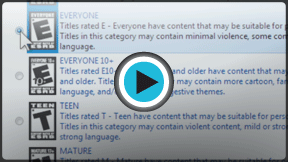
Windows 7
Managing User Accounts and Parental Controls
Introduction
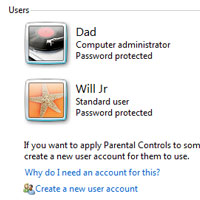
With Windows 7, everyone who uses your computer can have their own user account. This allows each person to have his or her own settings, and it allows you to set up Parental Controls to limit the types of games and programs your children are able to use.
In this lesson, you will learn how to create new user accounts, change account settings, and set up Parental Controls for your children's accounts.
Setting up multiple user accounts
Why should you have multiple user accounts?
If you wanted to, you could have a single account on your computer that everyone could use. But having multiple accounts has some advantages. If each user has his or her own account, then each person will have his or her own desktop for organizing files and folders. Each person also will be able to choose a specific desktop background, along with other personalization features. In addition, parents will be able to set Parental Controls for each child's account.
Standard vs. administrator accounts
Before you start making new user accounts, it's important to understand the two types of accounts:
- Standard: Standard accounts are the basic accounts you use for normal, everyday tasks. As a Standard user, you can do just about anything you would need to do, such as running software or personalizing your desktop. Also, Parental Controls can be placed on Standard accounts.
- Administrator: Administrator accounts are special accounts that are used for making certain changes to system settings or managing other people's accounts. They have full access to every setting on the computer. Every computer will have at least one Administrator account.
As you can see, Administrator accounts are more powerful. But for the same reason, Standard accounts are safer, so they are generally better for everyday use. In fact, you can make Administrator-level changes while logged into a Standard account; you will just need to provide an Administrator password when making the changes.
To go to your user accounts:
- Go to the Control Panel from the Start Menu.
- Click Add or remove user accounts.
 Going to user accounts
Going to user accounts - The Manage Accounts pane will appear. You will see all of the user accounts here, and you can add more accounts or manage existing ones.
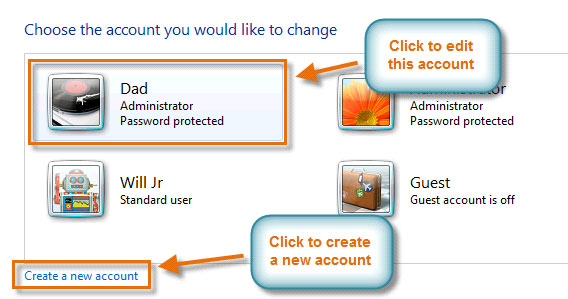 The Manage Accounts pane
The Manage Accounts pane
To create a new account:
- From the Manage Accounts pane, click Create a new account.
- Type an account name.
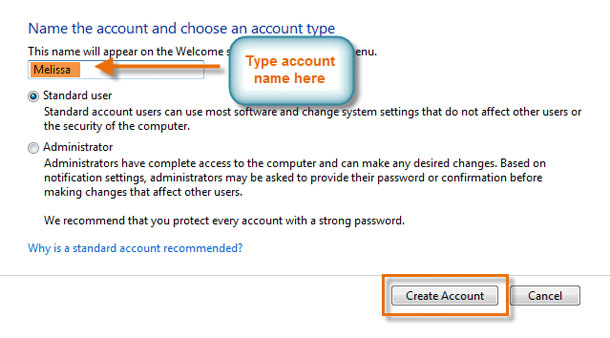 Creating an account
Creating an account - Select Standard user or Administrator.
- Click Create Account.
Changing an account's settings
Once you've created a new account, you may want to add a password or make other changes to the account's settings.
To create a password:
- From the Manage Accounts pane, click the account name or picture.
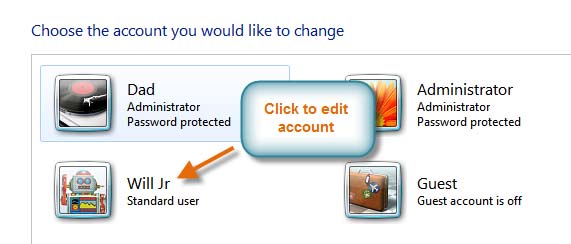 Edit an account
Edit an account - Click Create a password.
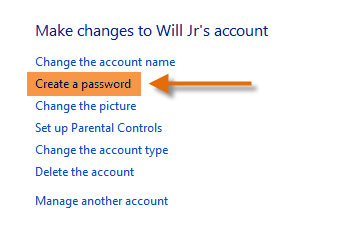 Create a password
Create a password - Type a password in the New password field, and retype it in the Confirm new password field.
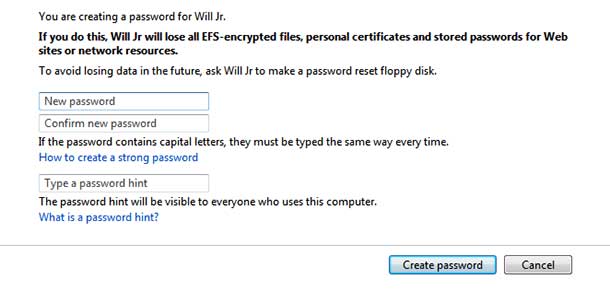 Type a password and hint
Type a password and hint - If you want, you can type a password hint to help you remember your password.
- Click Create password.
- To go back to the Manage Accounts pane, click Manage another account.
Account passwords are case sensitive, which means capital and lowercase letters are treated as different characters. For example, aBc1 is not the same as abc1.
To change your account picture:
You can also change the picture for any account. This picture appears next to the account name and helps you easily identify the account.
- From the Manage Accounts pane, click the account name or picture.
- Click Change the picture.
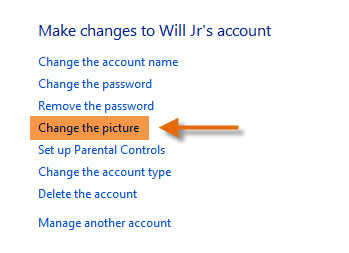 Change the picture
Change the picture - Select a picture, or click Browse for more pictures to select one of your own.
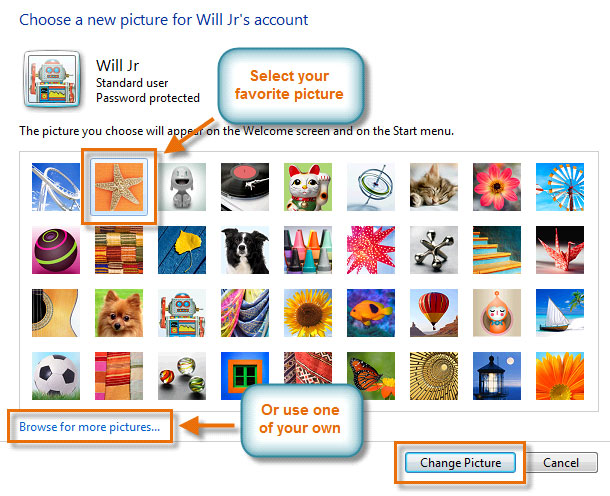 Account pictures
Account pictures - Click Change Picture.
Using Parental Controls
Windows 7 offers various Parental Controls to help you control the types of content your children can access. You can place parental controls on any Standard account, and each account can have different settings. If you have more than one child, each child can have access to different types of content, and you can always change the Parental Controls settings as your children get older.
Learn more about Parental Controls in this video.
Before you set up Parental Controls
You'll need to create an account for your child, if you haven't already. It should be a Standard account; you cannot apply Parental Controls to an Administrator account.
When you're setting up Parental Controls, it doesn't matter which account you're logged in to, but if you're logged in to a Standard account you'll need to provide an Administrator password before making any changes.
Make sure your children do not know your Administrator password, as it would allow them to change or disable Parental Controls for any user account.
To set up Parental Controls:
- Go to the Control Panel from the Start Menu.
- Click Set up parental controls for any user.
 Getting to Parental Controls
Getting to Parental Controls - Click on any Standard Account.
 Choose an account
Choose an account - Click On to turn Parental Controls on.
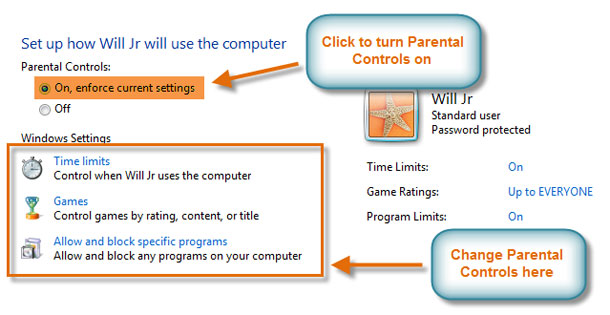 Parental Controls main page
Parental Controls main page - Now you can click Time limits, Games, or Allow and block specific programs to set the Parental Controls. We'll explore each of these on the next page.
To learn more about available parental control options you can use, check out our blog post on Five Free Ways to Protect Your Kids Online.
Changing your Parental Controls settings
Time limits
The time limits settings allow you to control when your children can use the computer. Click and drag from any box to allow or block a section of time. If you want, you can set different time limits on different days. For example, you may want to allow more computer use on weekends.
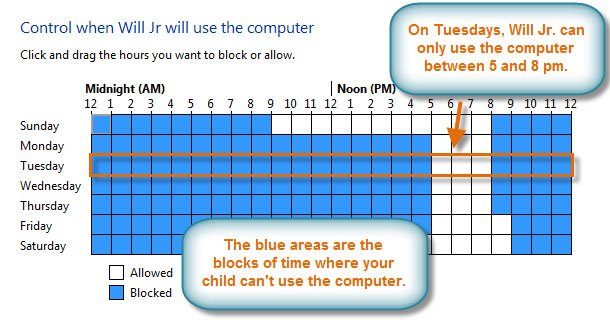 Time limits
Time limitsGames
The Games settings allow you to select which game ratings to allow, and you can also allow or block specific games. First, you'll have to click Yes to allow your children to play games, then you can change your Games settings.
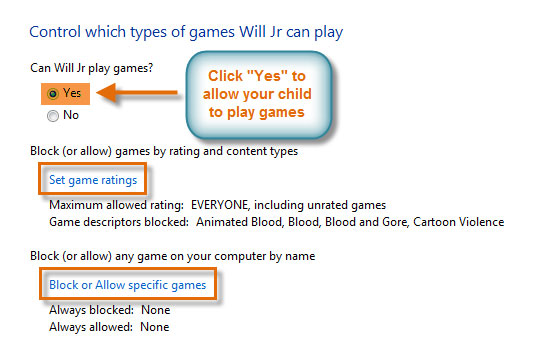 Games settings
Games settingsHere, we have selected "Everyone" as the highest rating allowed. This means your children can play games rated "Everyone" OR "Early Childhood."
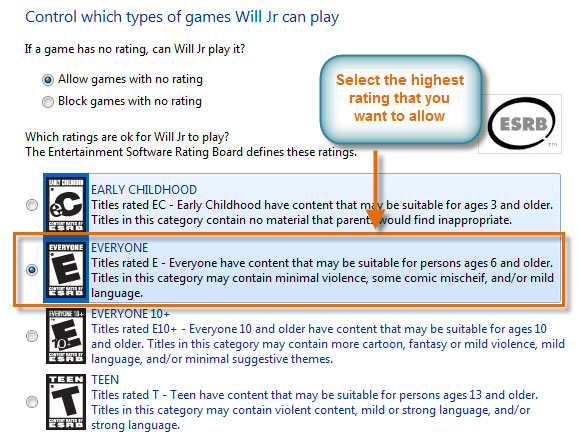 Game ratings
Game ratingsTo allow or block specific programs:
Allow and block specific programs controls which nongame programs your children can use. By default, your children can use all nongame programs. But there may be some programs you don't want your children to use, like a financial or email program. Here's how to block specific programs:
- Click Will Jr can only use the programs I allow.
- Click Check All.
- Uncheck the programs you want to block.
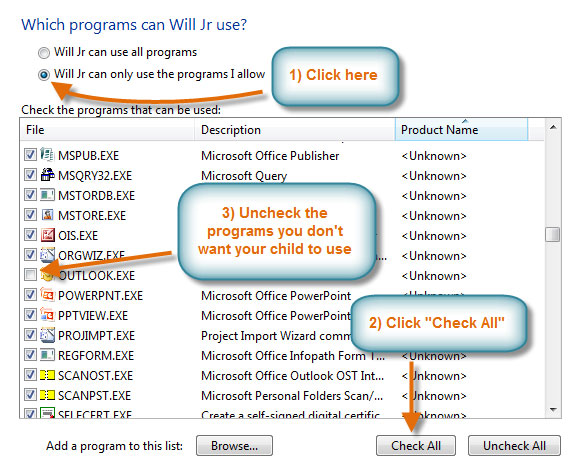 Non-game programs
Non-game programsConclusion
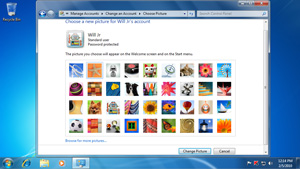
You can now create new accounts whenever you want, and all users will be able to easily access their own files and customize the appearance of Windows 7 while they're logged in to their respective accounts.
If you're using Parental Controls, take the time to familiarize yourself with the different controls offered. Windows 7 gives you a lot of flexibility when using Parental Controls, so you can apply them with as much or as little detail as you want.
